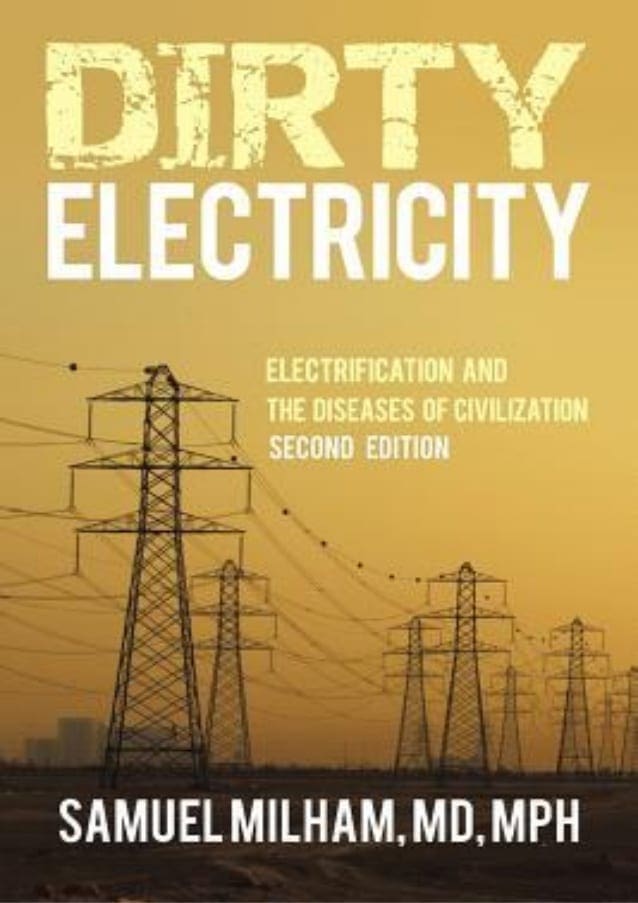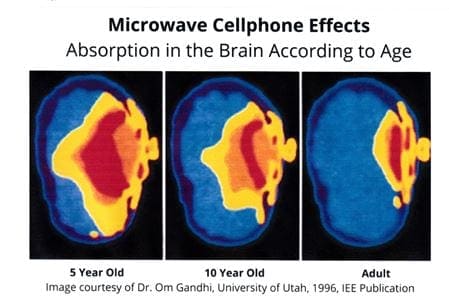If you’ve spent some time on my website, you know that EMF exposure affects your physical and mental health. But did you know that these effects are amplified if children are at the receiving end?
Children are at an increased risk of developing EMF-induced health problems because of their biological build.
In this post, we’ll discuss why EMF affects children more than adults and what you can do about it. So, let’s begin.
Why Do Children Face Greater Risks From EMF?
Now, I have a separate post about the health risks to babies from EMF radiation. In that post, I talk about the critical differences between babies and adults and why EMF affects babies more.
But babies aren’t the only demographic more vulnerable to health risks from EMF. Children in their middle childhood and adolescence also face tremendous health risks if they’re exposed to EMF for a long time.
And here’s why.

Want to Slash Your EMF Health Risks?
Want to Slash Your EMF Health Risks?
Good! Learn the one small change you should make right now.
Children’s Brains are Smaller, and Their Skulls are Thinner
Obviously, children are smaller than adults—and so are their heads.
But why does this matter?
Let’s say, for example, that a specific dose of cell phone radiation"Radiation" in the context of Electromagnetic Fields (EMF) refers to the process by which energy is emitted and transmitted through space or a material medium in the form of electromagnetic... penetrates three inches into your head. In a child with a smaller head, that penetrates more deeply, exposing a larger portion of the brain.
Add to that, they have thinner skulls. Since bone provides a degree of natural shielding against EMF radiation, this means that children have less natural protection.
In fact, a 2015 study funded by the Environmental Health Trust demonstrated that children absorb significantly more radiation from cell phones than adults.
But children (and babies) are not just small adults. They’re different physically, chemically, and biologically.
And as a result, they respond to toxins differently than we do.
Children’s Brains are Wetter
Not only are children’s brains smaller, but they also have a higher level of water content compared to an adult.
This means their brains conduct (and spread) EMF radiation more effectively and widely than ours do, amplifying the EMF-induced damage.
Children Are Growing – FAST
Besides their brains being wetter, they’re also growing fast. This means their cells are dividing and multiplying much more rapidly.
So, any damage in a cell’s DNA from EMF radiation exposure will be replicated and spread further throughout their bodies.
Children Are Younger
Add to all this, children are obviously younger and have longer to live. This means they will endure a higher level of cumulative exposure and live with EMF-induced damages for much longer.
Over time, the damage can multiply and spread and impact their bodies, creating an opportunity for chronic diseases like cancer to form.
So, Taken Together…
In the words of a team of researchers led by Dr. Leif Kheifets:
“Concerns about the potential vulnerability of children to radio frequencyRadio Frequency (or RF), a subset of EMF, encompasses electromagnetic wave frequencies ranging from about 3 kilohertz (kHz) to 300 gigahertz (GHz). These frequencies are extensively used in modern wireless... (RF) fields have been raised because of the potentially greater susceptibility of their developing nervous systems; in addition, their brain tissue is more conductive, RF penetration is greater relative to head size, and they will have a longer lifetime of exposure than adults.”
Scope of the Problem
So now that you understand why children are at a greater risk of developing EMF-induced health problems, the next natural question is how much of a concern this is in the 21st century.
To answer this, let’s look at the cell phone ownership stats among children.
In 2016, it was reported that the average age for kids to get their first smartphone was just 10.3 years.
Another 2017 report from Nielsen found that around 45% of US children between the ages of 10 to 12 had their own smartphone with a service plan rather than just WiFi, meaning they’re constantly connected to cell phone networks.
A 2019 survey by Common Sense Media found that 53% of children in the United States own a smartphone before the age of 11.
And a similar survey released in 2020 found that 53% of UK youth have a smartphone by the age of 7 (that’s 2nd grade)! By the time they are 11, a whopping 90% have smartphones.
The UK study had some other interesting (and disturbing findings), such as:
- 39% said they could not live without their phone;
- 57% said they always slept with their phone by their bed (which you should NOT do);
- 44% expressed discomfort at being in a location without cell service;
- 42% explained they are “constantly worried” about their battery dying.
What Does This Mean?
Cell phone ownership at such a young age means that younger generations are exposed to health risks from EMF earlier in life and for a longer duration. By the time they reach their teenage years, smartphone use is near to ubiquitous: in 2018, 95% of teens reported having access to one.
While the findings from each of these studies are a bit different, they agree that a lot of really young children have smartphones. And it’s pretty clear from the results that many of these surveyed children are expressing symptoms of cell phone addiction and are already demonstrating unhealthy habits with their tech.
That leads to increased exposure to EMF radiation.
Also, keep in mind that these stats are just about cell phones. And while cell phones are a significant source of EMF radiation, they are not nearly the only source. Not even close.
In today’s world, there are cell phones, laptops, computers, tablets, cell phone towers and antennas, WiFi routers, wearables, smart meters, other smart devices, and electric cars—all emitting EMF. And just like us, children are subjected to exposure from these sources.
This Level of Exposure Results In…
If you look at the statistics, cases of childhood illness and underdeveloped bodily systems are rising rapidly.
Given those facts, what are the differences we might expect to see in negative health effects for children when compared to adults?
Massive Growth in Childhood Cancer Incidence
Statistics say that childhood cancer incidence has grown significantly in the last 30 years. It went from an average of 2.1 new cases per 100,000 children to 3.4 new cases per 100,000. And that’s a giant leap.
Data from some sources even say that the actual number is around 5.4 per 100,000.
According to the World Health Organization (WHO), cancer is a leading cause of death in children and adolescents, mainly in high-income countries like the United States.
Their current data, however, confirms that the cause of 10% of childhood cancer cases is genetics. Why the majority of the young cancer patients who don’t have a history of the disease in their family suffer from this problem is still a puzzle.
The most common cancer types affecting children are leukemia, brain and central nervous system tumors, and lymphomas. And among these types, brain tumors and leukemia are the most prevalent.
But it’s not all bad news. As we’ve taken a massive leap forward with medical science and technology, the cancer survival rate has gone up from an overall 10% just 50 years ago to nearly 85% in 2021.
Now, even though specialized agencies like the WHO say that the leading cause for the proliferation of childhood cancer is unknown, many scientists worldwide have linked it with heavy EMF exposure.In addition, they’ve also confirmed that non-ionizing EMF causes many other health problems besides cancer. Have a look.
Increased Risk of Brain Tumors
Dr. Lennart HardellDr. Lennart Hardell, born on October 1, 1944, in Sweden, is a distinguished scientist known for his groundbreaking research in the field of electromagnetic fields (EMF) and, particularly, his extensive... and team published a study in 2007 in which they examined the incidence of malignant brain tumors among thousands of cell phone and cordless phone users.

This study is among the first epidemiological studies on this question, following a large number of subjects over an extended evaluation period.
Hardell and team found that not only does cell phone use increase the risk of malignant brain tumors, but that the risk increases with latency time (i.e., how much time had passed since the cell phone exposure) and cumulative use.
| Cumulative Hours on Digital Cell Phone | 1-5 Yrs Later | 5-10 Yrs Later | 10+ Yrs Later |
|---|---|---|---|
| 1-1,000 | 120% | 120% | 200% |
| 1,001 – 2,000 | 160% | 150% | 200% |
| 2,000+ | 180% | 160% | 640% |
Dr. Hardell’s data reveals some significantly increased risk from supposedly “safe” EMF doses—and that the risk increases both with the dose and the amount of time that passes.
Childhood Leukemia
As I’ve mentioned, cell phones aren’t the only source of EMF radiation. Among the many others are power"Power" in a scientific context refers to the rate at which work is done or energy is transferred. In simpler terms, it's how fast something is using energy. For example,... lines and electrical wiring in your home. This is because AC power emits a type of EMF called ELF (or extremely low frequencyDefinition and Characteristics Extremely Low Frequency (ELF) refers to the lower end of the electromagnetic (EM) spectrum with frequencies from 3 Hz to 300 Hz. This range lies below the...) radiation.
Dr. Sam MilhamDr. Sam Milham: Pioneer in EMF Research and the Discovery of Dirty Electricity Dr. Samuel Milham, born on October 18, 1929, is a distinguished epidemiologist and scientist known for his... coined a term to describe the stray EMF coming from these sources: dirty electricity.

Dr. Milham believes that exposure to this type of EMF is the source of significant health problems.
When power grids were initially created, they were installed in different parts of the country at different times. And Dr. Milham was able to show how increases in the death rate correlated with the onset of electrification, independent of where it occurred in the country.
In one case, building upon existing, accepted research that childhood leukemia showed a peak incidence when the child was 3 to 4 years old, Milham and his colleague, Eric Ossiander, published a study showing that the appearance of this characteristic peak correlated with the introduction of electrification.
They presented strong evidence that the incidence of leukemia in children between the ages of 3 and 4 was caused by EMF radiation. This type of childhood leukemia did not exist until the introduction of the power grid, and it still does not exist in the parts of the world that remain off the grid, like areas in sub-Saharan Africa.
Studies like these led a team of researchers, led by Dr. Devra Lee Davis, to publish a study in 2013 that concluded, in part, “no other environmental carcinogen has produced evidence of an increased risk in just one decade.”
Cognitive Decline
Obviously, cancer is a very concerning health risk. But it is not the only class of negative health effects linked to cell phone radiation exposure in children.
Other research out of the University of Helsinki in Finland gives reason to suspect that children are susceptible to more subtle brain effects. These researchers demonstrated cognitive dysfunction in children resulting from exposure to cell phone radiation.
For this study, they asked fifteen children to perform auditory memory functions with and without EMF exposure. Their findings suggest that “EMF emitted by mobile phones has effects on brain oscillatory responses during cognitive processing in children.”
In other words, exposure to cell phone radiation was shown to affect brain function in these children.
Memory Loss
Another study documented a specific symptom of cognitive decline in children resulting from exposure to cell phones: memory loss.
The peer-reviewed study, released in July 2018, was conducted by the Swiss Tropical and Public Health Institute (Swiss TPH).
The results suggest a link between exposure to radiofrequency electromagnetic fields (RF-EMFs) and memory performance in teens—yet another health risk of EMFs to be unearthed by the scientific community.
The study found that “cumulative RF-EMF brain exposure from mobile phone use over one year may have a negative effect on the development of figural memory performance in adolescents.”
What Exactly is Figural Memory?
Figural memory is what you use to commit visually presented information, like pictures, to your memory and recall them later.
It’s mainly located in the right brain hemisphere. An interesting finding of the study was that teens who held their cell phones up to the right side of their heads had the strongest memory deterioration.
“This may suggest that, indeed, RF-EMF absorbed by the brain is responsible for the observed associations,” said Martin Röösli, Head of Environmental Exposures and Health at Swiss TPH.
The 2018 Swiss TPH study isn’t the first to assess the effects of EMF on teenage brain development.
For example, a study published in 2017 concluded that cell phone usage “has a significant negative impact on working memory performance.” What’s more, these researchers found that “the effect is apparent even for a 5-minute use.” That’s right: even five minutes of using a cell phone impairs your memory.
This 2018 Swiss study is actually a follow-up to a 2015 study published in the scientific journal Environmental International, which also concluded that there was a strong correlation between RF-EMF exposure and figural memory performance in teens.
ADHD
In the past few years, many studies have identified a strong correlation between ADHD (attention deficit hyperactivity disorder) and exposure to EMF radiation.
ADHD is an increasingly common disorder that manifests in children as a malfunction in cognitive and behavioral activity.
As the American Psychiatric Association explains:
Attention deficit/hyperactivity disorder (ADHD) is one of the most common mental disorders affecting children. Symptoms of ADHD include
- Inattention (not being able to keep focus)
- Hyperactivity (excess movement that is not fitting to the setting)
- And impulsivity (hasty acts that occur at the moment without thought).
A 2008 study surveyed 13,000 Danish children with behavioral problems. The researchers found that children whose mothers reported cell phone use during pregnancy or children who started using cell phones at an early age were 80% more likely to have symptoms of ADHD.
Since then, the evidence linking cell phone radiation to ADHD has expanded considerably.
Academic Performance
With so much evidence accumulating demonstrating the links between cell phone radiation and impaired brain function, you would expect to see an impact on overall academic performance in children.
And in fact, that is what we find—not only because of the physiological and biological effects of cell phones but because they are quite simply a massive distraction.
A 2017 study from Rutgers University-New Brunswick, published in the journal Educational Psychology, found that students who use their cell phones and other devices for non-academic purposes during lectures perform worse in end-of-term exams.
Interestingly, it wasn’t just the students who used devices whose grades suffered. Students who didn’t use devices, but attended the same lectures as those who did, still ended up with lower grades.
So why is this?
Multitasking is a Myth
You’ve heard of multitasking. It’s often thought of as a valuable skill that will turn us into productivity superheroes.
But various studies have shown that multitasking is a myth. Our brains simply don’t work that way. Instead, we’re much more productive when focusing on one thing at a time.
“Many dedicated students think they can divide their attention in the classroom without harming their academic success,” said lead researcher and professor of psychology Arnold Glass in a press release, “but we found an insidious effect on exam performance and final grades.”
In other words, students may think they can multitask by listening to the lecture and using their internet-enabled devices simultaneously. But in reality, their attention is pinging back and forth between the two, leading to a decrease in focus.
While the students’ ability to comprehend the lectures wasn’t found to be compromised by this divided attention, long-term retention of the content was. The device-using students did fine on immediate in-class quiz questions—but their performance in later exams suffered by at least half a grade.
Enough to make a significant difference.
One question you may be asking is, why might students who simply go to classes where devices are allowed, even if they don’t use one themselves, have lower grades?
The answer is most likely that the mere presence of the devices causes a distraction to everyone present.
Presence of Devices Reduces Cognitive Capacity—A 2017 Study Says
It’s worth looking back to another well-publicized study from early 2017 that tested the effects of smartphones on cognitive performance.
In a series of experiments, participants completed tests with their smartphones either on their desks, out of sight but in the same room (e.g., in a bag or pocket), or with their phones completely inaccessible in another room.
The study found that “even when people are successful at maintaining sustained attention—as when avoiding the temptation to check their phones—the mere presence of these devices reduces available cognitive capacity.”
Perhaps not surprisingly, the participants with smartphones in another room displayed the highest available cognitive capacity out of the three groups; those with phones on their desks displayed the lowest.
How Cell Phone Safety Standards Ignore Children
Before concluding this post, I want to take a moment to highlight a major deficiency in cell phone radiation regulations.
Now, to be clear, I (and many others) believe that the regulations governing cell phone radiation emissions are vastly inadequate to protect any of us from the increasing number of negative health effects.
But, for the sake of argument, let’s say that cell phone emissions regulations are sufficient to protect us.
Even if that were true (and it’s not), these regulations are clearly inadequate to protect children.
See, in the United States and much of the rest of the world, the FCC (Federal Communications Commission) uses a measurement called SAR (or specific absorption rate) to regulate cell phone radiation.
In other words, cell phone radiation is regulated based on how much radiation you absorb when you use your phone.
But actually, that’s not entirely true. They’re not regulated based on how much EMF you absorb. They are regulated based on how much radiation is absorbed by a dummy that approximates a 240-pound man.

But the vast majority of children do not weigh 240 pounds. Not even close. The average weight of an 11-year-old is just 81.5 pounds–or about 25% of a SAR dummy.
And as I discussed above, children absorb more of this radiation.
So, not only are children more vulnerable to health risks and damage from cell phone radiation, but also cell phone regulations are fundamentally and entirely inadequate to protect children from this damage.
What Can You Do?
Simply put, using the same cell phone in the same position for the same length of time harms a child more than an adult. And as you can see, there’s a large and growing number of negative health effects that science has demonstrated can result from these exposures.
On this basis alone, it was entirely reasonable for the Stewart Report to suggest limiting EMF exposure to British infants and children:
…children may be more vulnerable because of their developing nervous system, the greater absorption of energy"Energy" is a fundamental concept in physics, often described as the ability to do work or cause change. In everyday terms, it's what is needed to move things, heat them... in the tissues of the head, and a longer lifetime of exposure. In line with our precautionary approach, at this time, we believe that the widespread use of mobile phones by children for non-essential calls should be discouraged. We also recommend that the mobile phone industry should refrain from promoting the use of mobile phones by children.
So, children have health risks from exposure to EMF radiation that are unique and higher than those of adults. But the good news is, it’s not difficult or expensive to help your child live a healthier life.
Educate Yourself
EMF is a complex subject. And when it comes to protecting yourself and your loved ones from EMF’s effects, education plays a crucial role.
For example, you might decide to use EMF shieldingEMF shielding refers to the practice of reducing the electromagnetic field (EMF) exposure in a particular area by blocking or altering the electromagnetic waves with barriers made of conductive or... products to help defend yourself and your children from EMF radiation. But, if there’s even a tiny mistake in your EMF shielding efforts, it can prevent them from working—or worse, amplify the effects. That’s one reason why education is so important.
We have a huge database of resources on EMF, its effects, and protection. And you can read them for free on the Shield Your Body website.
I recommend starting with our EMF Radiation Health Safety and Protection for Children at Home post.
Know That the Best EMF Protection is Always Free
Right after hearing about EMF hazards, most people run to the internet searching for products to minimize their EMF exposure.
And while there are lab-tested and effective EMF shielding products in the market, they’re not the first thing you should be looking to get when starting your EMF mitigating journey.
It surprises many when I say that “the best EMF protection is always free.” You just need to follow what we call the two key rules of EMF protection. They’re “Minimize Use & Maximize Distance.”
Learn more about it in my post, “What is the Best EMF Protection? Hint: It’s Free. And You Can Start Right Now.”
Advocate
EMF mitigation is a collaborative effort. What your neighbor does EMF-wise can have an impact on you as well. So, you need to advocate for safer EMF practices around you.
And mind you that when I say advocate, in no way do I mean that you should start hating and demolishing EMF sources.
EMF advocacy is about making sure that the majority of people know about EMF’s adverse effects, so they can start practicing safer ways to exist alongside technology.
Learn more about how to talk with people in a way that convinces them to make a change in their lives on my EMF Advocacy page.
Use EMF Shielding Products
As I already said, the first thing you should do to minimize your EMF exposure is to follow the two key rules of EMF protection. But this doesn’t mean EMF shielding products don’t help.
Lab-tested EMF shielding products, like the ones my company makes and sells, act as a second line of defense in your EMF shielding journey to further mitigate your EMF exposure.
Visit the SYB store to choose products that best fit your needs from our extensive catalog.
Final Thoughts
Although the intensity may vary, EMF affects people of all age groups—be it babies, children, teenagers, adults, or senior citizens.
But the solution isn’t to condemn EMF. That’s because EMF is what makes most of our technological inventions work.
The solution is to build a healthier relationship with technology.
And how do you do that?
Let the experts tell you. Visit The Healthier Tech Podcast, where a wide variety of experts share their tips on living alongside technology in a safer, healthier way. It’s available on all major platforms.












